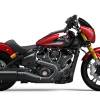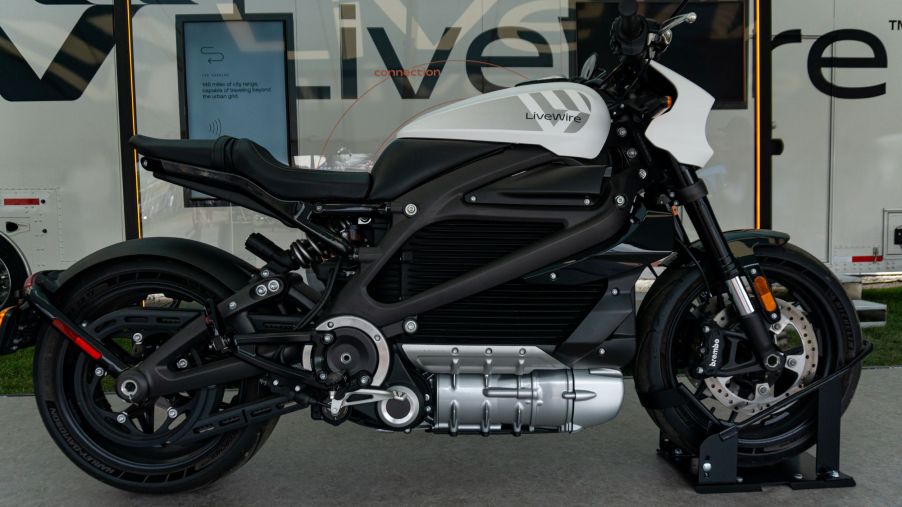
2021 LiveWire One Thrills Like Only an Electric Motorcycle Can
The Serial 1 e-bikes aren’t the only new two-wheeled EVs Harley-Davidson is releasing in 2021. This year, Harley-Davidson also has an updated version of its sole electric motorcycle, the LiveWire. Only now, because LiveWire is technically a sub-brand, it has a new name: the LiveWire One. Recently, I got to ride it at the 2021 International Motorcycle Show in Chicago. And in the process, I experienced that riding an electric motorcycle brings some distinct delights.
What makes the 2021 LiveWire One different than the 2020 Harley-Davidson LiveWire?
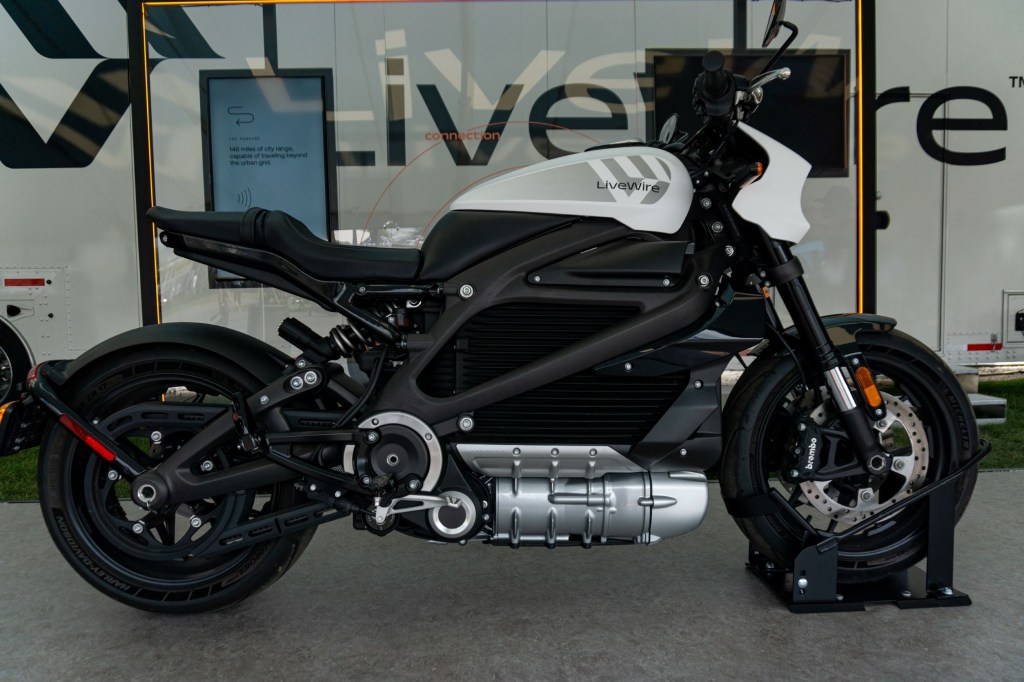
| Spec | 2021 LiveWire One | 2020 Harley-Davidson LiveWire |
| Power | 105 hp | 105 hp |
| Torque | 86 lb-ft | 86 lb-ft |
| Final drive | Belt | Belt |
| 0-60 mph time | 3.0 seconds | 3.12 seconds (Cycle World) |
| Claimed city range | 146 miles | 146 miles |
| Front suspension | Fully-adjustable Showa SFF-BP inverted fork | Fully-adjustable Showa SFF-BP inverted fork |
| Rear suspension | Fully-adjustable Showa BFRC mono-shock | Fully-adjustable Showa BFRC mono-shock |
| Curb weight | 562 lb | 549 lb |
| Starting price | $21,999 | $29,799 |
At first glance, the 2021 LiveWire One looks almost identical to the 2020 Harley-Davidson LiveWire. They have the same horsepower, torque, claimed range, and roughly identical 0-60 mph times. Both electric Harley motorcycles also have the same 45° maximum lean angle. And like the ‘original’ LiveWire, the 2021 One has a 110-mph top speed.
In addition, both the 2020 Harley-Davidson LiveWire and 2021 LiveWire One come standard with cornering ABS, traction control, wheelie control, rear-wheel-slip control, and regenerative Brembo brakes. Each also comes with a 4.3” TFT touchscreen, Bluetooth, and a USB-C outlet. Plus, both bikes can recharge from 0-100% in an hour when hooked up to a DC fast charger.
So, what’s changed now that the Harley-Davidson LiveWire is now its sub-brand’s leading product? Besides the lower price, slightly higher curb weight, and new color scheme, essentially nothing, Cycle World says. At least, nothing mechanical. Harley-Davidson claims that the One has “evolved software and hardware” compared to the 2020 bike.
In short, the 2021 LiveWire One is basically a cheaper 2020 LiveWire. However, that’s not exactly a bad thing. Against rivals like the Zero SR/F, the LiveWire’s sticker price was a noticeable disadvantage. But with that drawback gone, what’s left is an electric motorcycle Cycle World called “the four-star general of electrics.”
At least, in theory.
Riding and believing the 2021 LiveWire One, my first EV, at IMS Chicago
Although I’ve written about two- and four-wheeled EVs, I’ve never actually driven or ridden one. That changed at IMS Outdoors Chicago 2021 when I took the new LiveWire One on a multi-mile test ride. As I haven’t ridden the 2020 bike, I can’t say what’s different about the 2021 One. But I can confirm what Motorcyclist said about the earlier LiveWire: this bike is “exhilarating to ride.”
Numbers on a page don’t describe what a rush accelerating an electric motorcycle like the 2021 LiveWire One is. There’s no delay while you flick a shifter or balance the clutch; just twist and go. Once you do, the LiveWire pulls effortlessly forwards with a sound like the Jetsons meets a mini turbine. If you’re worried that electric motorcycles are too quiet, the One should set your mind at ease. And leave you giggling within a few minutes.
How does the 2021 LiveWire One ride and handle?
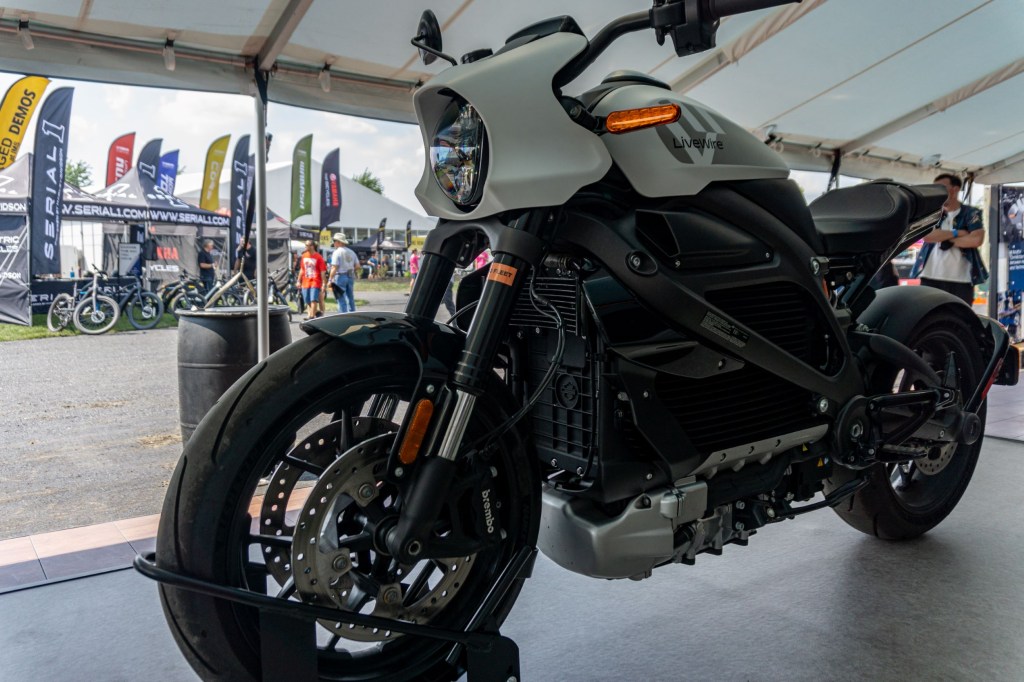
2021 LiveWire One front 3/4 view | Matthew Skwarczek, MotorBiscuit 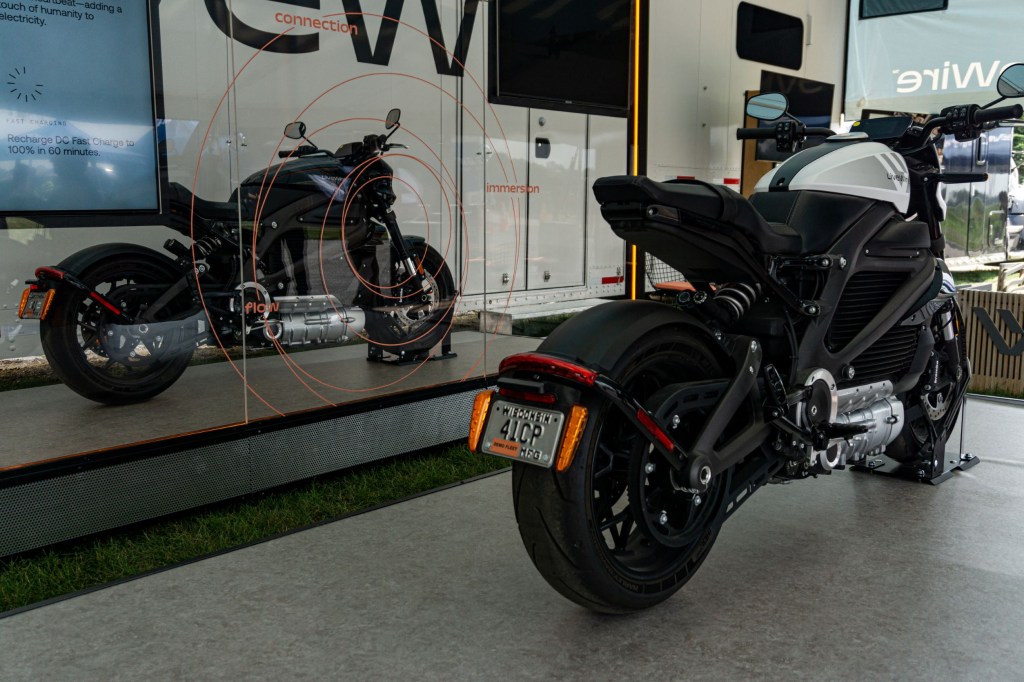
2021 LiveWire One rear 3/4 view | Matthew Skwarczek, MotorBiscuit 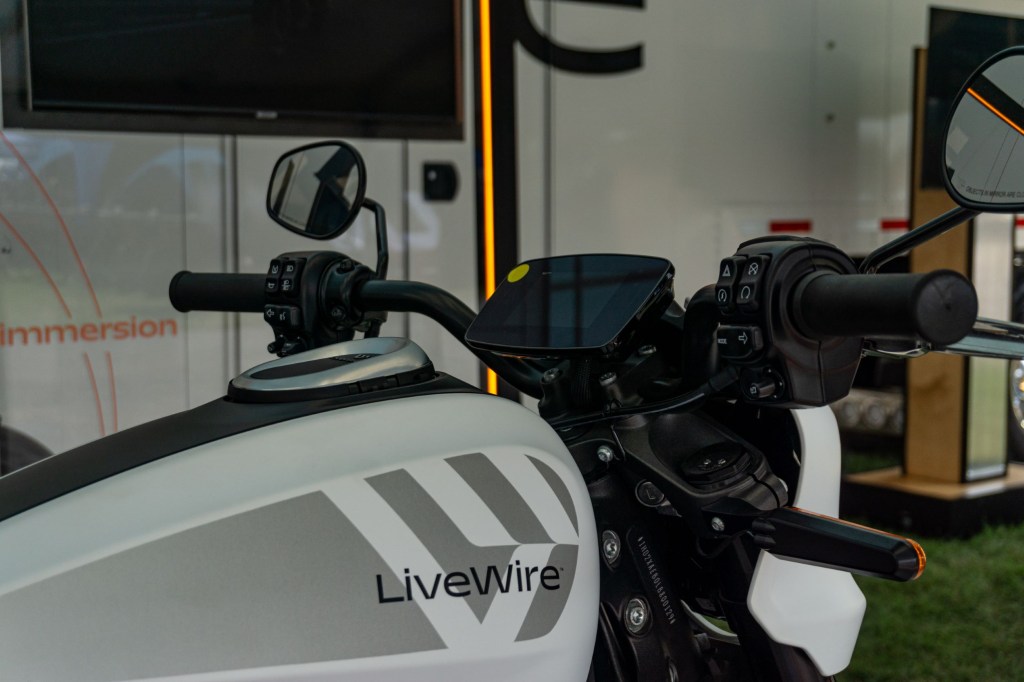
The 2021 LiveWire One’s handlebars and TFT display | Matthew Skwarczek, MotorBiscuit 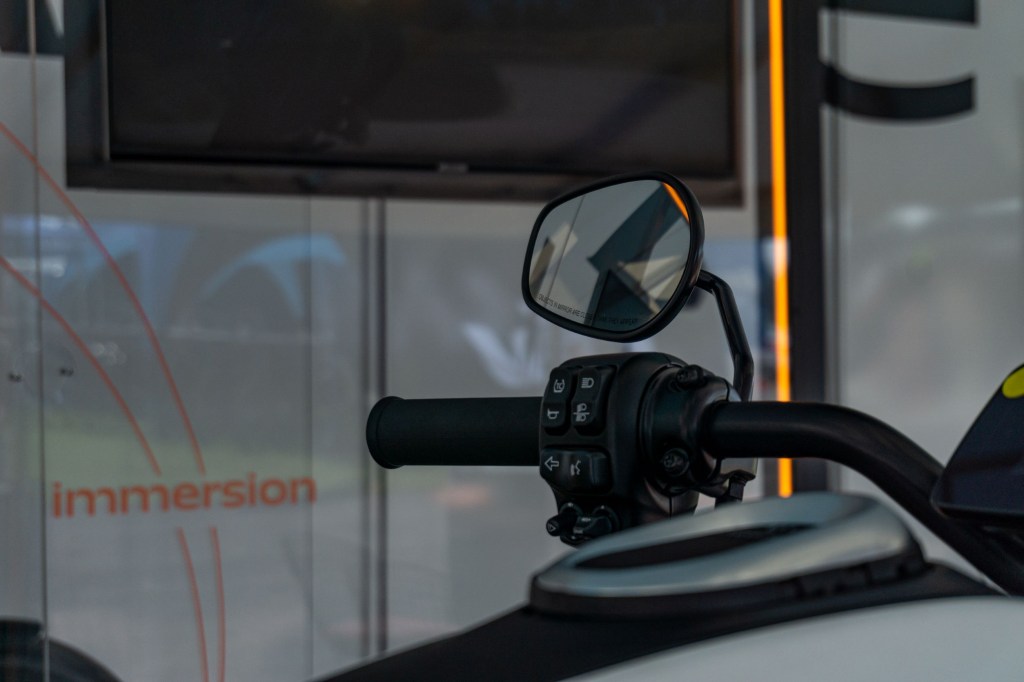
2021 LiveWire One left handgrip closeup | Matthew Skwarczek, MotorBiscuit 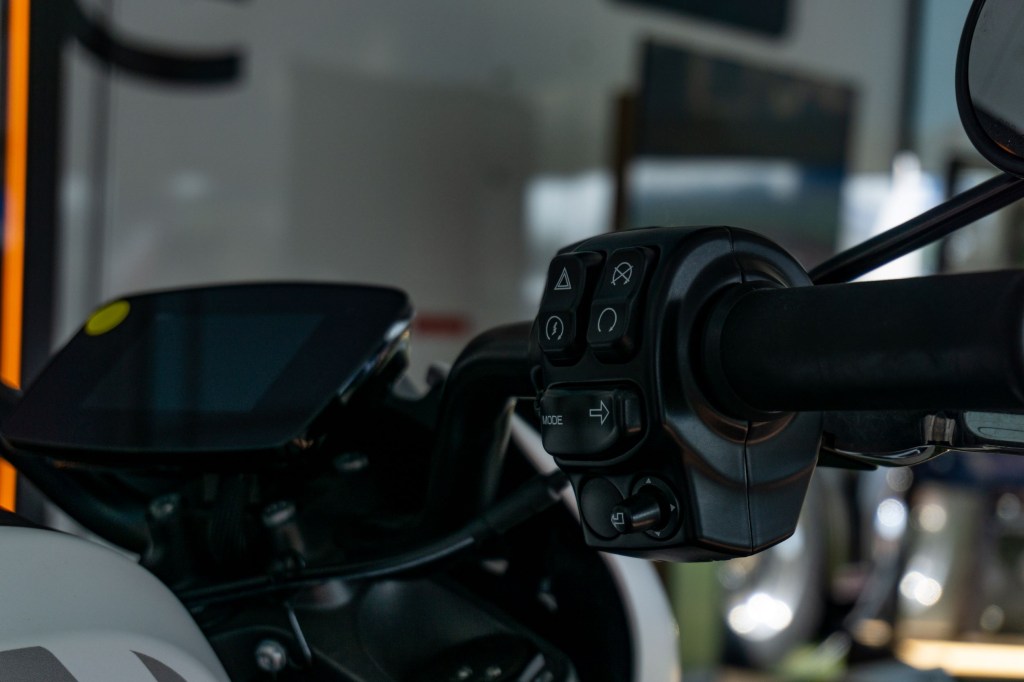
2021 LiveWire One right handgrip closeup | Matthew Skwarczek, MotorBiscuit
But the acceleration isn’t the only thing the 2021 LiveWire One does well. It’s a standard motorcycle, with mid-set foot controls and a comfortable, upright riding position. Yes, you do feel the bike’s 562-lb weight when you’re stationary, Roadshow reports. But it’s a different story once you’re moving. The LiveWire One is fun to ride on sweeping roads, transitioning between corners surprisingly easily, Motorcyclist says. Although it’s not a sportbike, it’s stable in the corners; it rides comfortably, too. Plus, the Brembo brakes offer excellent levels of feedback.
Speaking of, like the 2020 Harley-Davidson LiveWire, the One lets the rider know it’s switched on through haptic feedback. It’s a gentle pulse through the seat that Harley-Davidson calls the ‘heartbeat.’ This sounds gimmicky, but it’s genuinely helpful, especially for electric motorcycle newbies, Car and Driver notes. And I’m inclined to agree.
As for the rest of the bike, the 2021 One’s screen is easy to read even in bright sunlight. And all the switchgear feels solid. Some riders might not like that it has Harley’s traditional turn-signal buttons, rather than a single switch. But overall, the One is a solid, thrilling electric motorcycle.
Is Harley-Davidson’s electric motorcycle worth buying?
As noted earlier, the 2020 Harley-Davidson LiveWire’s relatively high price made it a tough sell for some. And admittedly, at just under $22K, the 2021 One isn’t exactly cheap.
However, it now costs roughly the same as the Zero SR/F, another sporty electric standard motorcycle. And it’s now about $2000 cheaper than another “scary quick” motorcycle, the Ducati Streetfighter V4 S, Car and Driver notes. But is that enough to make the One a worthwhile purchase?
The answer to that question depends on how and where you ride. If you mostly stick to urban or mixed highway/city riding, going electric makes a lot of sense. But if you plan to do a significant amount of long-distance touring, it’s a different story. That’s not to say you couldn’t do road trips on a LiveWire: Ewan McGregor and Charley Boorman did. It’s just that they’re not the bike’s strong suit.
Nevertheless, Harley-Davidson is slowly expanding the LiveWire dealership network, with more dealers to come in fall 2021. So, if you get a chance, test-ride a 2021 One. It might just make you understand what makes riding electric motorcycles a distinct experience.
Follow more updates from MotorBiscuit on our Facebook page.
